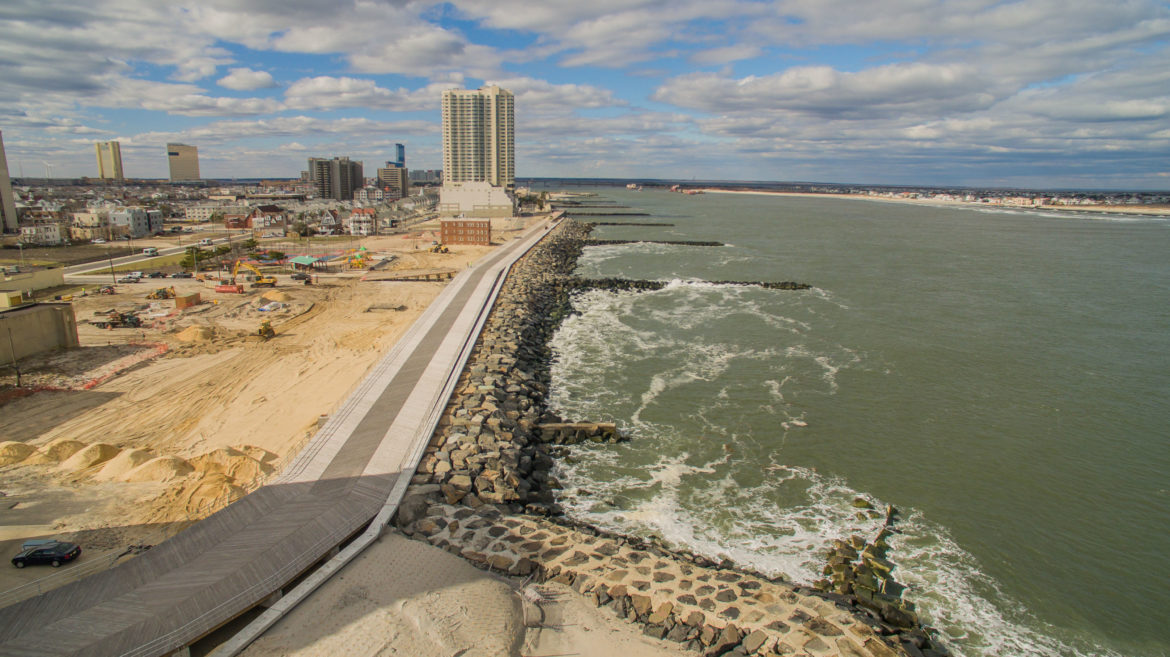Looking at an aerial photograph showing off Atlantic City’s near-desolate South Inlet neighborhood and its new $38-million storm-protection structure, the New Yorker had a question.
“Did you have a lot of challenges justifying your cost analysis?”

Photo by USACE / USACE
Absecon Inlet Sea Wall
The U.S. Army Corps of Engineers did not, in fact, have much trouble justifying the money spent on Atlantic City’s new sea wall for two reasons. Firstly, the cost-benefit study began in the 1990s before the South Inlet cemented its zombie neighborhood status. And secondly, there was an insanely valuable piece of property – albeit in disrepair – that stretched around the Atlantic-fronting corner of Absecon Island: The Boardwalk.
That Boardwalk, though, did cause some challenges of its own, Keith Watson of the Army Corps’ Philadelphia District, said. Watson was talking to an audience of urban planning experts, including a contingent from the New York City Economic Development Corp., in town to visit with counterparts at the Casino Reinvestment Development Authority. We were all at the Little Water Distillery, not that far from the Inlet under discussion, in an area where back-bay flooding is a not infrequent nuisance. The Urban Land Institute had organized a meeting to discuss the sea wall in the context of coastal resiliency.
The Boardwalk was not the point of the project. But Superstorm Sandy, which washed bits and pieces of the already-damaged Inlet-fronting boards onto Atlantic Ave and into homes, reignited federal and state support for finishing the Absecon Sea Wall. And the city negotiated a redesign of the project that would place a rebuilt Boardwalk atop the wall. This being an inter-governmental project it was subject to some curious negotiations over cost and construction. Yes, the city could have its expensive Brazilian wood for the Boardwalk. But since the Army Corps was running the project under a federal contract, it was subject to the Buy American Act.
“It caused us problems,” said Watson. “We can’t just go and source the Brazilian hardwood and bring it in. The city actually helped us with this. We had to find a supplier that imports the logs and makes all the wood and mills and makes and chips and installs all the wood here in the United States.
“It’s beautiful.”
Most visitors will notice those beautiful boards and not the 99,000 tons of stone – sourced locally – that form the sea wall. They are also unlikely to notice the state-of-the-art drainage built inside the wall so that any water from a storm surge can flow back out to the ocean. (The engineers doubled the city’s drainage capacity in the Inlet. Working from estimates for the rain and surge that a 50-year storm might bring, the city’s pipes are now big enough to handle 30-36 inches of water that feeds into a concrete catch-basin below the ground). The contractor also had to dig out and clear up oil tanks and other debris from the Inlet before the work could begin. “The area is in much better shape than it was,” Watson said.
The visiting New Yorkers were puzzled by the isolated homes in the Inlet, along the site of the wall. Were they a problem? Was eminent domain needed for the site?
“None of the existing homes protested,” said Watson, adding that they willingly gave over their easements. The vacant lots were another matter. Sometimes it was hard to track down owners. Some sites had to be condemned. Maintenance work for the sea wall required a minimum of 15 feet of unimproved land behind the Boardwalk. Getting easements was complicated. In fact, the city owned land where the Army Corps wanted to put its wall, necessitating some finessing of the already-complicated financing agreement.
The urbanists at the distillery had hoped to take a tour of the wall – but it was cancelled because of the rain.
Does the sea wall seem a futile development, for a barrier island that suffers frequent backbay flooding?
Existing forecasts for sea-level rise were factored into the wall’s construction, Watson said, but it was a near-negligible factor, since the sea rise is measured in inches. Sandy brought up 10 feet of water in one night.
The engineers are studying New Jersey’s back bay flooding now. One idea is to block inlets, like they do in Holland and Venice, Watson said. But there is no easy fix. Focusing money on one place is more economical.
“Can we do a project that’s going to protect everybody?” Watson wondered out loud. “The hardest, most energetic damage-causing factors are easier to protect against economically than the slow rise of the back bays.”